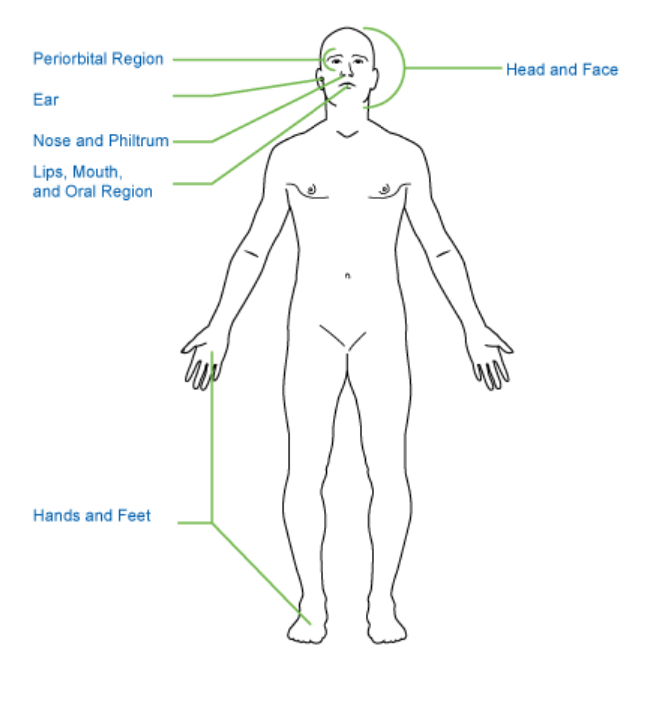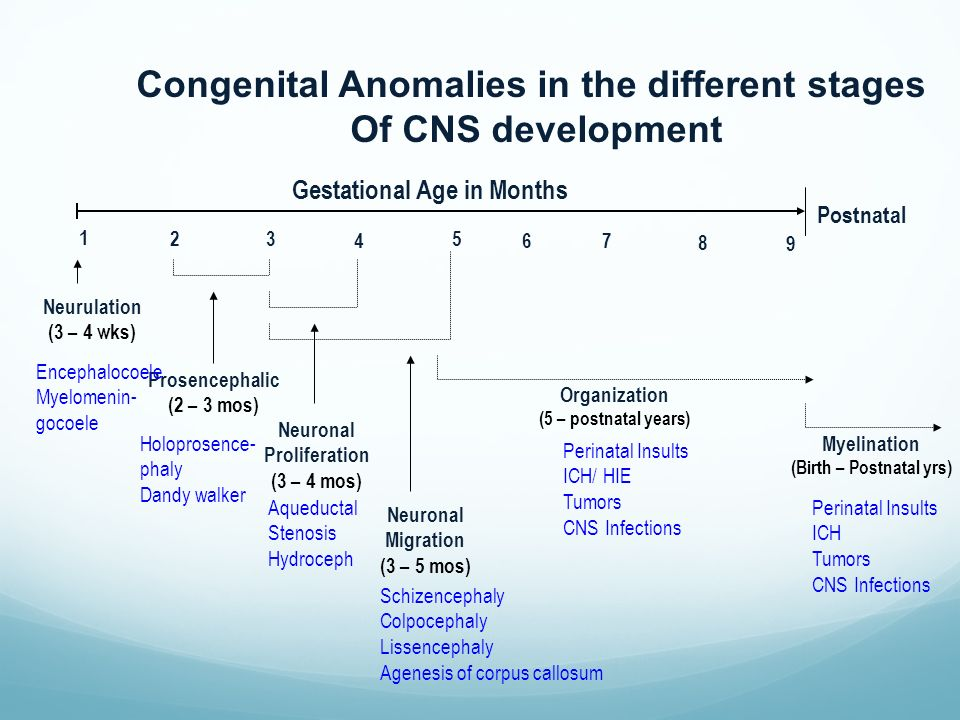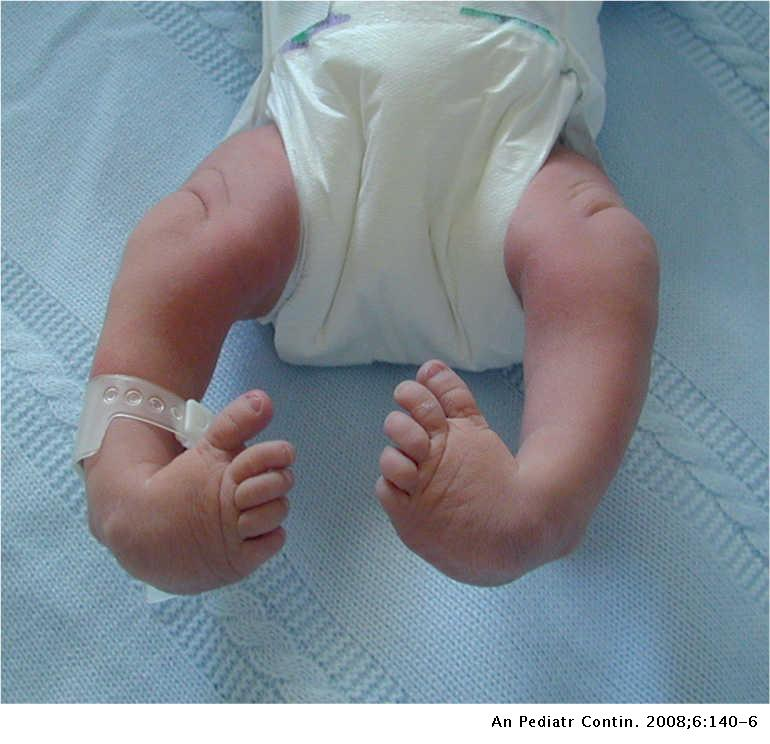¿Cuando sospechar una enfermedad genética?
Exploración anatómica regional.

Se debe prestar una especial atención a aquellas regiones anatómicas con un desarrollo embriológico complejo.
Existe terminología específica para describir cada una de las alteraciones anatómicas identificables, disponible en Elements of Morphology. También puede codificarse el fenotipo mediante los términos HPO, para poder realizar búsquedas informáticas inequívocas.
Patrones reconocibles.
- Deformación.
- Malformación. Se pueden clasificar en malformaciones mayores y malformaciones menores.
- Disrupción.
- Displasia.
- Secuencia.
- Síndrome. Discapacidad intelectual sindrómica.
- Asociación.
Existe un conjunto de enfermedades metabólicas que cursan con dismorfia característica, motivo por el que deben conocerse, ya que se trata de enfermedades con tratamiento específico.
332710
{332710:7FDSIUMC}
1
vancouver
50
default
4640
https://neuropediatoolkit.org/wp-content/plugins/zotpress/
%7B%22status%22%3A%22success%22%2C%22updateneeded%22%3Afalse%2C%22instance%22%3Afalse%2C%22meta%22%3A%7B%22request_last%22%3A0%2C%22request_next%22%3A0%2C%22used_cache%22%3Atrue%7D%2C%22data%22%3A%5B%7B%22key%22%3A%227FDSIUMC%22%2C%22library%22%3A%7B%22id%22%3A332710%7D%2C%22meta%22%3A%7B%22creatorSummary%22%3A%22Rufo%20Campos%22%2C%22parsedDate%22%3A%222002%22%2C%22numChildren%22%3A0%7D%2C%22bib%22%3A%22%26lt%3Bdiv%20class%3D%26quot%3Bcsl-bib-body%26quot%3B%20style%3D%26quot%3Bline-height%3A%201.35%3B%20%26quot%3B%26gt%3B%5Cn%20%20%26lt%3Bdiv%20class%3D%26quot%3Bcsl-entry%26quot%3B%20style%3D%26quot%3Bclear%3A%20left%3B%20%26quot%3B%26gt%3B%5Cn%20%20%20%20%26lt%3Bdiv%20class%3D%26quot%3Bcsl-left-margin%26quot%3B%20style%3D%26quot%3Bfloat%3A%20left%3B%20padding-right%3A%200.5em%3B%20text-align%3A%20right%3B%20width%3A%201em%3B%26quot%3B%26gt%3B1.%26lt%3B%5C%2Fdiv%26gt%3B%26lt%3Bdiv%20class%3D%26quot%3Bcsl-right-inline%26quot%3B%20style%3D%26quot%3Bmargin%3A%200%20.4em%200%201.5em%3B%26quot%3B%26gt%3BRufo%20Campos%20M.%20Dismorfolog%26%23xED%3Ba%2C%20Gen%26%23xE9%3Btica%20y%20Neurolog%26%23xED%3Ba%20Infantil.%20RevNeurol%20%5BInternet%5D.%202002%20%5Bcited%202023%20Feb%2020%5D%3B35%2801%29%3A50.%20Available%20from%3A%20%26lt%3Ba%20class%3D%26%23039%3Bzp-ItemURL%26%23039%3B%20href%3D%26%23039%3Bhttps%3A%5C%2F%5C%2Fwww.neurologia.com%5C%2Farticulo%5C%2F2002147%26%23039%3B%26gt%3Bhttps%3A%5C%2F%5C%2Fwww.neurologia.com%5C%2Farticulo%5C%2F2002147%26lt%3B%5C%2Fa%26gt%3B%26lt%3B%5C%2Fdiv%26gt%3B%5Cn%20%20%26lt%3B%5C%2Fdiv%26gt%3B%5Cn%26lt%3B%5C%2Fdiv%26gt%3B%22%2C%22data%22%3A%7B%22itemType%22%3A%22journalArticle%22%2C%22title%22%3A%22Dismorfolog%5Cu00eda%2C%20Gen%5Cu00e9tica%20y%20Neurolog%5Cu00eda%20Infantil%22%2C%22creators%22%3A%5B%7B%22creatorType%22%3A%22author%22%2C%22firstName%22%3A%22Miguel%22%2C%22lastName%22%3A%22Rufo%20Campos%22%7D%5D%2C%22abstractNote%22%3A%22Introduction.%20Dysmorphology%20is%20a%20relatively%20modern%20science%20which%20is%20very%20wide%2C%20continuously%20advancing%20and%20inevitably%20related%20to%20infantile%20neurology%20and%20genetics.%20Development.%20A%20neuropaediatrician%2C%20before%20making%20indiscriminate%20use%20of%20such%20major%20complementary%20investigations%20as%20neurogenetics%20and%20imaging%20techniques%20to%20diagnose%20a%20dysmorphic%20syndrome%2C%20should%20obtain%20a%20detailed%20clinical%20history%20and%2C%20particularly%2C%20a%20very%20careful%20physical%20examination%2C%20including%20adequate%20neurological%20examination.%20Thus%20in%20neuropaediatrics%20the%20final%20diagnosis%20and%20early%20determination%20of%20normality%20or%20abnormality%20is%20based%20on%20two%20things%3A%20the%20clinical%20semiology%20derived%20from%20the%20clinical%20history%20and%20neurological%20examination%2C%20and%20complementary%20investigations%20%28sophisticated%20or%20not%29%20which%20make%20us%20relate%20these%20findings%20to%20clinical%20data.%20Results.%20A%20large%20proportion%20of%20neurological%20disorders%2C%20especially%20those%20involving%20the%20intellect%2C%20are%20found%20in%20patients%20with%20some%20type%20of%20chromosome%20anomaly%2C%20which%20cause%20less%20than%206%25%20of%20all%20malformations%20of%20the%20central%20nervous%20system.%20At%20the%20present%20time%20a%20wide%20range%20of%20dysmorphic%20syndromes%20are%20recognized%2C%20with%20or%20without%20accompanying%20chromosome%20anomalies.%20Many%20of%20these%20are%20also%20associated%20with%20mental%20deficiency%20or%20signs%20of%20neurological%20deficiency.%20Genetic%20studies%20should%20be%20requested%20when%20monogenetic%20disorders%20or%20mitochondrial%20disorders%20are%20suspected%2C%20and%20in%20multifactorial%20disorders.%20It%20has%20been%20shown%20that%20the%20presence%20of%20minor%20dysmorphic%20defects%20in%20children%20with%20epileptic%20seizures%20is%20associated%20with%20a%20much%20worse%20prognosis%2C%20possibly%20because%20it%20is%20also%20associated%20with%20cerebral%20malformations.%20Often%20these%20minor%20anomalies%20are%20seen%20in%20similar%20form%20in%20close%20relations%20of%20the%20children%20involved.%20It%20is%20therefore%20necessary%20to%20take%20care%20in%20evaluation%20of%20these%20defects.%20%5BREV%20NEUROL%202002%3B%2035%3A%2050-2%5D%20Key%20words.%20Childhood.%20Dysmorphology.%20Genetics.%20Minor%20morphological%20anomalies.%22%2C%22date%22%3A%222002%22%2C%22language%22%3A%22es%22%2C%22DOI%22%3A%2210.33588%5C%2Frn.3501.2002147%22%2C%22ISSN%22%3A%220210-0010%22%2C%22url%22%3A%22https%3A%5C%2F%5C%2Fwww.neurologia.com%5C%2Farticulo%5C%2F2002147%22%2C%22collections%22%3A%5B%22UUQCBK9V%22%5D%2C%22dateModified%22%3A%222025-09-27T21%3A58%3A08Z%22%7D%7D%5D%7D
1.
Rufo Campos M. Dismorfología, Genética y Neurología Infantil. RevNeurol [Internet]. 2002 [cited 2023 Feb 20];35(01):50. Available from: https://www.neurologia.com/articulo/2002147
Embriopatías. Patrones malformativos de base embriológica.
Malformaciones del SNC. Neuroembriopatías.

332710
{332710:9K67PSUJ},{332710:MMJ2ISXM},{332710:GA6MR3QK},{332710:HF92TQCC}
1
vancouver
50
default
4640
https://neuropediatoolkit.org/wp-content/plugins/zotpress/
%7B%22status%22%3A%22success%22%2C%22updateneeded%22%3Afalse%2C%22instance%22%3Afalse%2C%22meta%22%3A%7B%22request_last%22%3A0%2C%22request_next%22%3A0%2C%22used_cache%22%3Atrue%7D%2C%22data%22%3A%5B%7B%22key%22%3A%22HF92TQCC%22%2C%22library%22%3A%7B%22id%22%3A332710%7D%2C%22meta%22%3A%7B%22creatorSummary%22%3A%22Stiles%20and%20Jernigan%22%2C%22parsedDate%22%3A%222010-12%22%2C%22numChildren%22%3A3%7D%2C%22bib%22%3A%22%26lt%3Bdiv%20class%3D%26quot%3Bcsl-bib-body%26quot%3B%20style%3D%26quot%3Bline-height%3A%201.35%3B%20%26quot%3B%26gt%3B%5Cn%20%20%26lt%3Bdiv%20class%3D%26quot%3Bcsl-entry%26quot%3B%20style%3D%26quot%3Bclear%3A%20left%3B%20%26quot%3B%26gt%3B%5Cn%20%20%20%20%26lt%3Bdiv%20class%3D%26quot%3Bcsl-left-margin%26quot%3B%20style%3D%26quot%3Bfloat%3A%20left%3B%20padding-right%3A%200.5em%3B%20text-align%3A%20right%3B%20width%3A%201em%3B%26quot%3B%26gt%3B1.%26lt%3B%5C%2Fdiv%26gt%3B%26lt%3Bdiv%20class%3D%26quot%3Bcsl-right-inline%26quot%3B%20style%3D%26quot%3Bmargin%3A%200%20.4em%200%201.5em%3B%26quot%3B%26gt%3BStiles%20J%2C%20Jernigan%20TL.%20The%20Basics%20of%20Brain%20Development.%20Neuropsychol%20Rev%20%5BInternet%5D.%202010%20Dec%20%5Bcited%202016%20July%2028%5D%3B20%284%29%3A327%26%23x2013%3B48.%20Available%20from%3A%20%26lt%3Ba%20class%3D%26%23039%3Bzp-ItemURL%26%23039%3B%20href%3D%26%23039%3Bhttp%3A%5C%2F%5C%2Fwww.ncbi.nlm.nih.gov%5C%2Fpmc%5C%2Farticles%5C%2FPMC2989000%5C%2F%26%23039%3B%26gt%3Bhttp%3A%5C%2F%5C%2Fwww.ncbi.nlm.nih.gov%5C%2Fpmc%5C%2Farticles%5C%2FPMC2989000%5C%2F%26lt%3B%5C%2Fa%26gt%3B%26lt%3B%5C%2Fdiv%26gt%3B%5Cn%20%20%26lt%3B%5C%2Fdiv%26gt%3B%5Cn%26lt%3B%5C%2Fdiv%26gt%3B%22%2C%22data%22%3A%7B%22itemType%22%3A%22journalArticle%22%2C%22title%22%3A%22The%20Basics%20of%20Brain%20Development%22%2C%22creators%22%3A%5B%7B%22creatorType%22%3A%22author%22%2C%22firstName%22%3A%22Joan%22%2C%22lastName%22%3A%22Stiles%22%7D%2C%7B%22creatorType%22%3A%22author%22%2C%22firstName%22%3A%22Terry%20L.%22%2C%22lastName%22%3A%22Jernigan%22%7D%5D%2C%22abstractNote%22%3A%22Over%20the%20past%20several%20decades%2C%20significant%20advances%20have%20been%20made%20in%20our%20understanding%20of%20the%20basic%20stages%20and%20mechanisms%20of%20mammalian%20brain%20development.%20Studies%20elucidating%20the%20neurobiology%20of%20brain%20development%20span%20the%20levels%20of%20neural%20organization%20from%20the%20macroanatomic%2C%20to%20the%20cellular%2C%20to%20the%20molecular.%20Together%20this%20large%20body%20of%20work%20provides%20a%20picture%20of%20brain%20development%20as%20the%20product%20of%20a%20complex%20series%20of%20dynamic%20and%20adaptive%20processes%20operating%20within%20a%20highly%20constrained%2C%20genetically%20organized%20but%20constantly%20changing%20context.%20The%20view%20of%20brain%20development%20that%20has%20emerged%20from%20the%20developmental%20neurobiology%20literature%20presents%20both%20challenges%20and%20opportunities%20to%20psychologists%20seeking%20to%20understand%20the%20fundamental%20processes%20that%20underlie%20social%20and%20cognitive%20development%2C%20and%20the%20neural%20systems%20that%20mediate%20them.%20This%20chapter%20is%20intended%20to%20provide%20an%20overview%20of%20some%20very%20basic%20principles%20of%20brain%20development%2C%20drawn%20from%20contemporary%20developmental%20neurobiology%2C%20that%20may%20be%20of%20use%20to%20investigators%20from%20a%20wide%20range%20of%20disciplines.%22%2C%22date%22%3A%222010-12%22%2C%22language%22%3A%22%22%2C%22DOI%22%3A%2210.1007%5C%2Fs11065-010-9148-4%22%2C%22ISSN%22%3A%221040-7308%22%2C%22url%22%3A%22http%3A%5C%2F%5C%2Fwww.ncbi.nlm.nih.gov%5C%2Fpmc%5C%2Farticles%5C%2FPMC2989000%5C%2F%22%2C%22collections%22%3A%5B%22UUQCBK9V%22%2C%22D96TI4VP%22%5D%2C%22dateModified%22%3A%222025-11-10T09%3A34%3A58Z%22%7D%7D%2C%7B%22key%22%3A%229K67PSUJ%22%2C%22library%22%3A%7B%22id%22%3A332710%7D%2C%22meta%22%3A%7B%22creatorSummary%22%3A%22Barkovich%20et%20al.%22%2C%22parsedDate%22%3A%222012-05-01%22%2C%22numChildren%22%3A2%7D%2C%22bib%22%3A%22%26lt%3Bdiv%20class%3D%26quot%3Bcsl-bib-body%26quot%3B%20style%3D%26quot%3Bline-height%3A%201.35%3B%20%26quot%3B%26gt%3B%5Cn%20%20%26lt%3Bdiv%20class%3D%26quot%3Bcsl-entry%26quot%3B%20style%3D%26quot%3Bclear%3A%20left%3B%20%26quot%3B%26gt%3B%5Cn%20%20%20%20%26lt%3Bdiv%20class%3D%26quot%3Bcsl-left-margin%26quot%3B%20style%3D%26quot%3Bfloat%3A%20left%3B%20padding-right%3A%200.5em%3B%20text-align%3A%20right%3B%20width%3A%201em%3B%26quot%3B%26gt%3B1.%26lt%3B%5C%2Fdiv%26gt%3B%26lt%3Bdiv%20class%3D%26quot%3Bcsl-right-inline%26quot%3B%20style%3D%26quot%3Bmargin%3A%200%20.4em%200%201.5em%3B%26quot%3B%26gt%3BBarkovich%20AJ%2C%20Guerrini%20R%2C%20Kuzniecky%20RI%2C%20Jackson%20GD%2C%20Dobyns%20WB.%20A%20developmental%20and%20genetic%20classification%20for%20malformations%20of%20cortical%20development%3A%20update%202012.%20Brain%20%5BInternet%5D.%202012%20May%201%20%5Bcited%202017%20Feb%2026%5D%3B135%285%29%3A1348%26%23x2013%3B69.%20Available%20from%3A%20%26lt%3Ba%20class%3D%26%23039%3Bzp-ItemURL%26%23039%3B%20href%3D%26%23039%3Bhttps%3A%5C%2F%5C%2Facademic.oup.com%5C%2Fbrain%5C%2Farticle%5C%2F135%5C%2F5%5C%2F1348%5C%2F304670%5C%2FA-developmental-and-genetic-classification-for%26%23039%3B%26gt%3Bhttps%3A%5C%2F%5C%2Facademic.oup.com%5C%2Fbrain%5C%2Farticle%5C%2F135%5C%2F5%5C%2F1348%5C%2F304670%5C%2FA-developmental-and-genetic-classification-for%26lt%3B%5C%2Fa%26gt%3B%26lt%3B%5C%2Fdiv%26gt%3B%5Cn%20%20%26lt%3B%5C%2Fdiv%26gt%3B%5Cn%26lt%3B%5C%2Fdiv%26gt%3B%22%2C%22data%22%3A%7B%22itemType%22%3A%22journalArticle%22%2C%22title%22%3A%22A%20developmental%20and%20genetic%20classification%20for%20malformations%20of%20cortical%20development%3A%20update%202012%22%2C%22creators%22%3A%5B%7B%22creatorType%22%3A%22author%22%2C%22firstName%22%3A%22A.%20James%22%2C%22lastName%22%3A%22Barkovich%22%7D%2C%7B%22creatorType%22%3A%22author%22%2C%22firstName%22%3A%22Renzo%22%2C%22lastName%22%3A%22Guerrini%22%7D%2C%7B%22creatorType%22%3A%22author%22%2C%22firstName%22%3A%22Ruben%20I.%22%2C%22lastName%22%3A%22Kuzniecky%22%7D%2C%7B%22creatorType%22%3A%22author%22%2C%22firstName%22%3A%22Graeme%20D.%22%2C%22lastName%22%3A%22Jackson%22%7D%2C%7B%22creatorType%22%3A%22author%22%2C%22firstName%22%3A%22William%20B.%22%2C%22lastName%22%3A%22Dobyns%22%7D%5D%2C%22abstractNote%22%3A%22%22%2C%22date%22%3A%222012%5C%2F05%5C%2F01%22%2C%22language%22%3A%22%22%2C%22DOI%22%3A%2210.1093%5C%2Fbrain%5C%2Faws019%22%2C%22ISSN%22%3A%220006-8950%22%2C%22url%22%3A%22https%3A%5C%2F%5C%2Facademic.oup.com%5C%2Fbrain%5C%2Farticle%5C%2F135%5C%2F5%5C%2F1348%5C%2F304670%5C%2FA-developmental-and-genetic-classification-for%22%2C%22collections%22%3A%5B%22U3HZHDFD%22%5D%2C%22dateModified%22%3A%222025-11-10T08%3A35%3A52Z%22%7D%7D%2C%7B%22key%22%3A%22GA6MR3QK%22%2C%22library%22%3A%7B%22id%22%3A332710%7D%2C%22meta%22%3A%7B%22creatorSummary%22%3A%22Barkovich%20et%20al.%22%2C%22parsedDate%22%3A%222007-12%22%2C%22numChildren%22%3A1%7D%2C%22bib%22%3A%22%26lt%3Bdiv%20class%3D%26quot%3Bcsl-bib-body%26quot%3B%20style%3D%26quot%3Bline-height%3A%201.35%3B%20%26quot%3B%26gt%3B%5Cn%20%20%26lt%3Bdiv%20class%3D%26quot%3Bcsl-entry%26quot%3B%20style%3D%26quot%3Bclear%3A%20left%3B%20%26quot%3B%26gt%3B%5Cn%20%20%20%20%26lt%3Bdiv%20class%3D%26quot%3Bcsl-left-margin%26quot%3B%20style%3D%26quot%3Bfloat%3A%20left%3B%20padding-right%3A%200.5em%3B%20text-align%3A%20right%3B%20width%3A%201em%3B%26quot%3B%26gt%3B1.%26lt%3B%5C%2Fdiv%26gt%3B%26lt%3Bdiv%20class%3D%26quot%3Bcsl-right-inline%26quot%3B%20style%3D%26quot%3Bmargin%3A%200%20.4em%200%201.5em%3B%26quot%3B%26gt%3BBarkovich%20AJ%2C%20Millen%20KJ%2C%20Dobyns%20WB.%20A%20developmental%20classification%20of%20malformations%20of%20the%20brainstem.%20Ann%20Neurol.%202007%20Dec%3B62%286%29%3A625%26%23x2013%3B39.%26lt%3B%5C%2Fdiv%26gt%3B%5Cn%20%20%20%26lt%3B%5C%2Fdiv%26gt%3B%5Cn%26lt%3B%5C%2Fdiv%26gt%3B%22%2C%22data%22%3A%7B%22itemType%22%3A%22journalArticle%22%2C%22title%22%3A%22A%20developmental%20classification%20of%20malformations%20of%20the%20brainstem%22%2C%22creators%22%3A%5B%7B%22creatorType%22%3A%22author%22%2C%22firstName%22%3A%22A.%20James%22%2C%22lastName%22%3A%22Barkovich%22%7D%2C%7B%22creatorType%22%3A%22author%22%2C%22firstName%22%3A%22Kathleen%20J.%22%2C%22lastName%22%3A%22Millen%22%7D%2C%7B%22creatorType%22%3A%22author%22%2C%22firstName%22%3A%22William%20B.%22%2C%22lastName%22%3A%22Dobyns%22%7D%5D%2C%22abstractNote%22%3A%22OBJECTIVE%3A%20With%20advances%20in%20imaging%20and%20genetics%2C%20malformations%20of%20the%20brainstem%20are%20being%20more%20commonly%20identified.%20We%20describe%20and%20classify%20brainstem%20anomalies%20in%20138%20patients%20ascertained%20over%20a%20period%20of%2010%20years%5CnMETHODS%3A%20Magnetic%20resonance%20imaging%20studies%20and%2C%20where%20available%2C%20clinical%20records%20of%20the%20patients%20were%20retrospectively%20reviewed.%20Malformations%20were%20segregated%20according%20to%20magnetic%20resonance%20findings%20and%20classified%20when%20possible%20by%20embryological%20mechanisms%5CnRESULTS%3A%20The%20most%20common%20location%20for%20anomalies%20was%20the%20pons%2C%20which%20was%20involved%20in%20114%20patients.%20The%20midbrain%20was%20involved%20in%2045%20patients%2C%20whereas%20the%20medulla%20was%20involved%20in%2014.%20In%2053%20patients%2C%20more%20than%201%20region%20was%20affected%20%28all%203%20regions%20in%206%20patients%2C%20midbrain%20and%20pons%20in%2039%2C%20and%20medulla%20and%20pons%20in%208%29.%20The%20malformations%20were%20divided%20into%20four%20groups%3A%20%281%29%20malformations%20with%20abnormal%20brainstem%20segmentation%2C%20%282%29%20malformations%20with%20segmental%20hypoplasia%2C%20%283%29%20postsegmentation%20malformations%2C%20and%20%284%29%20malformations%20associated%20with%20abnormal%20cortical%20organization%5CnINTERPRETATION%3A%20The%20malformations%20of%20the%20brainstem%20identified%20in%20this%20study%20were%20diverse%20and%20complex.%20This%20proposed%20classification%20organizes%20them%20into%20groupings%20based%20on%20known%20genetics%20and%20embryological%20events.%20Use%20of%20this%20system%20will%20help%20clinicians%20and%20scientists%20to%20better%20understand%20these%20disorders%20and%2C%20ultimately%2C%20to%20better%20counsel%20families%20of%20affected%20patients.%22%2C%22date%22%3A%22Dec%202007%22%2C%22language%22%3A%22eng%22%2C%22DOI%22%3A%2210.1002%5C%2Fana.21239%22%2C%22ISSN%22%3A%221531-8249%22%2C%22url%22%3A%22%22%2C%22collections%22%3A%5B%22U3HZHDFD%22%5D%2C%22dateModified%22%3A%222025-11-10T08%3A35%3A43Z%22%7D%7D%2C%7B%22key%22%3A%22MMJ2ISXM%22%2C%22library%22%3A%7B%22id%22%3A332710%7D%2C%22meta%22%3A%7B%22creatorSummary%22%3A%22Barkovich%22%2C%22parsedDate%22%3A%222012%22%2C%22numChildren%22%3A0%7D%2C%22bib%22%3A%22%26lt%3Bdiv%20class%3D%26quot%3Bcsl-bib-body%26quot%3B%20style%3D%26quot%3Bline-height%3A%201.35%3B%20%26quot%3B%26gt%3B%5Cn%20%20%26lt%3Bdiv%20class%3D%26quot%3Bcsl-entry%26quot%3B%20style%3D%26quot%3Bclear%3A%20left%3B%20%26quot%3B%26gt%3B%5Cn%20%20%20%20%26lt%3Bdiv%20class%3D%26quot%3Bcsl-left-margin%26quot%3B%20style%3D%26quot%3Bfloat%3A%20left%3B%20padding-right%3A%200.5em%3B%20text-align%3A%20right%3B%20width%3A%201em%3B%26quot%3B%26gt%3B1.%26lt%3B%5C%2Fdiv%26gt%3B%26lt%3Bdiv%20class%3D%26quot%3Bcsl-right-inline%26quot%3B%20style%3D%26quot%3Bmargin%3A%200%20.4em%200%201.5em%3B%26quot%3B%26gt%3BBarkovich%20AJ.%20Developmental%20disorders%20of%20the%20midbrain%20and%20hindbrain.%20Front%20Neuroanat%20%5BInternet%5D.%202012%20%5Bcited%202017%20Feb%2026%5D%3B6.%20Available%20from%3A%20%26lt%3Ba%20class%3D%26%23039%3Bzp-ItemURL%26%23039%3B%20href%3D%26%23039%3Bhttp%3A%5C%2F%5C%2Fjournal.frontiersin.org%5C%2Farticle%5C%2F10.3389%5C%2Ffnana.2012.00007%5C%2Fabstract%26%23039%3B%26gt%3Bhttp%3A%5C%2F%5C%2Fjournal.frontiersin.org%5C%2Farticle%5C%2F10.3389%5C%2Ffnana.2012.00007%5C%2Fabstract%26lt%3B%5C%2Fa%26gt%3B%26lt%3B%5C%2Fdiv%26gt%3B%5Cn%20%20%26lt%3B%5C%2Fdiv%26gt%3B%5Cn%26lt%3B%5C%2Fdiv%26gt%3B%22%2C%22data%22%3A%7B%22itemType%22%3A%22journalArticle%22%2C%22title%22%3A%22Developmental%20disorders%20of%20the%20midbrain%20and%20hindbrain%22%2C%22creators%22%3A%5B%7B%22creatorType%22%3A%22author%22%2C%22firstName%22%3A%22Anthony%20James%22%2C%22lastName%22%3A%22Barkovich%22%7D%5D%2C%22abstractNote%22%3A%22Malformations%20of%20the%20midbrain%20and%20hindbrain%20have%20become%20topics%20of%20considerable%20interest%20in%20the%20neurology%20and%20neuroscience%20literature%20in%20recent%20years.%20The%20combined%20advances%20of%20imaging%2C%20and%20molecular%20biology%20have%20improved%20analyses%20of%20structures%20in%20these%20areas%20of%20the%20central%20nervous%20system%2C%20while%20advances%20in%20genetics%20have%20made%20it%20clear%20that%20malformations%20of%20these%20structures%20are%20often%20associated%20with%20dysfunction%20or%20malformation%20of%20other%20organ%20systems.%20This%20review%20focuses%20upon%20the%20importance%20of%20communication%20between%20clinical%20researchers%20and%20basic%20scientists%20in%20the%20advancement%20of%20knowledge%20of%20this%20group%20of%20disorders.%20Disorders%20of%20anteroposterior%20patterning%2C%20cerebellar%20hypoplasias%2C%20disorders%20associated%20with%20defects%20of%20the%20pial%20limiting%20membrane%20%28cobblestone%20cortex%29%2C%20disorders%20of%20the%20Reelin%20pathway%2C%20and%20disorders%20of%20the%20primary%20cilium%5C%2Fbasal%20body%20organelle%20%28molar%20tooth%20malformations%29%20are%20the%20main%20focus%20of%20the%20review.%22%2C%22date%22%3A%222012%22%2C%22language%22%3A%22English%22%2C%22DOI%22%3A%2210.3389%5C%2Ffnana.2012.00007%22%2C%22ISSN%22%3A%221662-5129%22%2C%22url%22%3A%22http%3A%5C%2F%5C%2Fjournal.frontiersin.org%5C%2Farticle%5C%2F10.3389%5C%2Ffnana.2012.00007%5C%2Fabstract%22%2C%22collections%22%3A%5B%22U3HZHDFD%22%2C%222W9A8NTT%22%5D%2C%22dateModified%22%3A%222025-09-27T22%3A52%3A51Z%22%7D%7D%5D%7D
1.
Stiles J, Jernigan TL. The Basics of Brain Development. Neuropsychol Rev [Internet]. 2010 Dec [cited 2016 July 28];20(4):327–48. Available from: http://www.ncbi.nlm.nih.gov/pmc/articles/PMC2989000/
1.
Barkovich AJ, Guerrini R, Kuzniecky RI, Jackson GD, Dobyns WB. A developmental and genetic classification for malformations of cortical development: update 2012. Brain [Internet]. 2012 May 1 [cited 2017 Feb 26];135(5):1348–69. Available from: https://academic.oup.com/brain/article/135/5/1348/304670/A-developmental-and-genetic-classification-for
1.
Barkovich AJ, Millen KJ, Dobyns WB. A developmental classification of malformations of the brainstem. Ann Neurol. 2007 Dec;62(6):625–39.
1.
Barkovich AJ. Developmental disorders of the midbrain and hindbrain. Front Neuroanat [Internet]. 2012 [cited 2017 Feb 26];6. Available from: http://journal.frontiersin.org/article/10.3389/fnana.2012.00007/abstract

